5 Epic Island Hikes in Greece for Spring...
This spring, five majestic peaks across...

Filoti, in the heart of Naxos, is one of the largest villages in the Cyclades, with a rich tradition in livestock farming and music.
© Dimitris Tosidis
Naxos, the largest island in the Cyclades, is a place of many faces and boundless charm. There’s the Naxos of ancient monuments, where passionate history enthusiasts climb rocks to reach the Cave of Zeus; the Naxos of sandy beaches, where French retirees sunbathe naked as early as May; and the Naxos of orchards and pastures, where farmers tirelessly tend to their land and livestock. Then there’s Hora, with its busy city atmosphere, double-parked SUVs, and trendy cafés with tattooed baristas. All these aspects make up a living, breathing island that has always carved its own distinct path, thanks to its size, diverse landscape, and central location in the Aegean Sea.
Naxos continues to thrive by investing in primary industries such as livestock farming, cheesemaking, agriculture, and viticulture. It’s a place that invites exploration beyond its sandy shores and emerald waters. Discover the charming inland villages, the remarkable monuments, and the local cuisine, which takes pride in using homegrown produce such as quality meats, cheeses, and wines produced in the island’s vineyards.
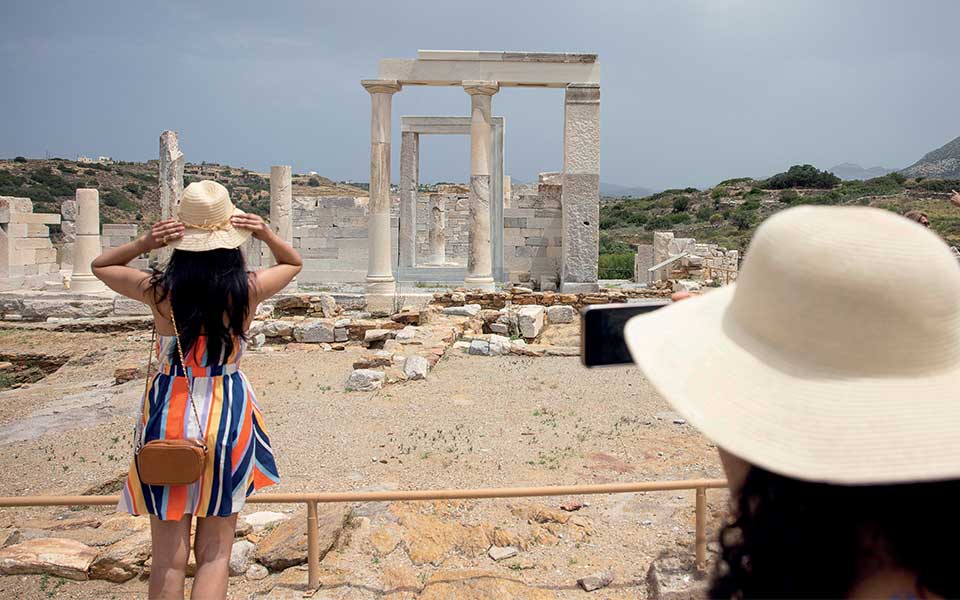
The Temple of Demeter in Gyroulas Sangri attracts visitors from around the world.
© Dimitris Tosidis
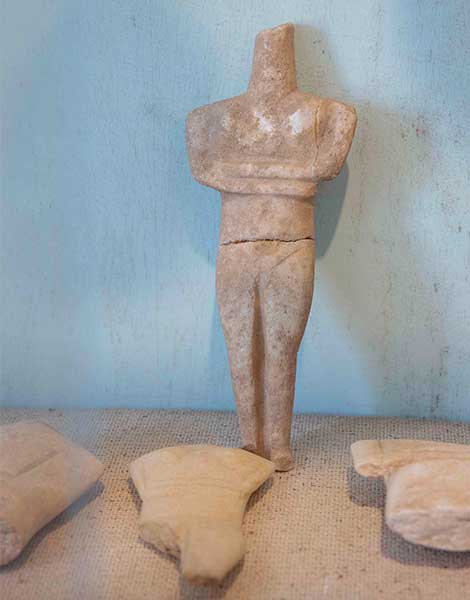
Figurine from the “Michalis Bardanis” Archaeological Collection in Apeiranthos.
© Dimitris Tosidis
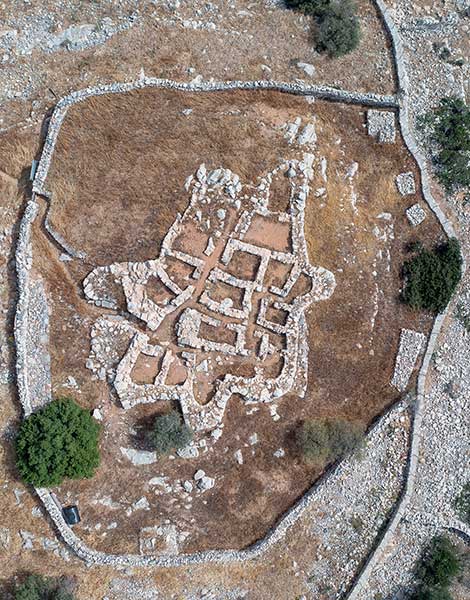
The prehistoric acropolis of Panormos in SE Naxos, opposite Koufonisia.
© Dimitris Tosidis
Naxos, an island rich in marble and emery, has been a major quarrying center since antiquity. Three ancient Kouros statues lie in the open, providing a one-of-a-kind spectacle in which these treasures can be appreciated in nature rather than in a museum. The Kouros of Apollonas, also known as the Colossus of Dionysus, is the largest and most remote statue on Naxos, located at its northern tip. This 10.7-meter, 60-ton archaic statue, thought to represent Dionysus, lies horizontally and has most likely never been moved from its original quarry site; its sculpted beard is still visible. The remaining two Kouroi are found further inland. The 5.5-meter Kouros of Flerio, dating from 570 BC, rests in a field beneath an oak tree, its legs broken. The Kouros of Faragi, from the 6th century BC, portrays a naked figure with a head but no face. It is a 10-15 minute walk from the site of the Kouros of Flerio and cannot be reached by car.
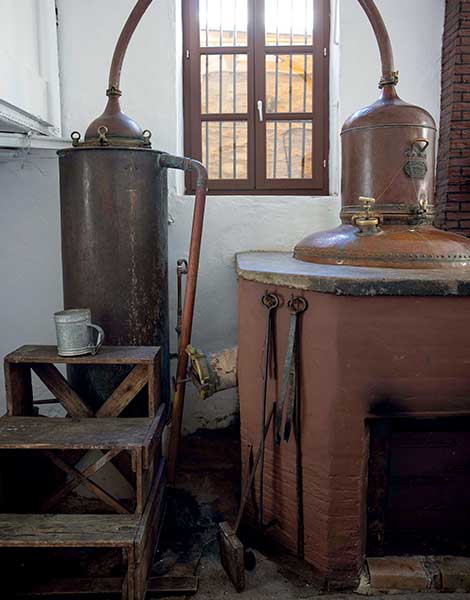
At the Vallindras Distillery in Halki, citron leaves are distilled.
© Dimitris Tosidis
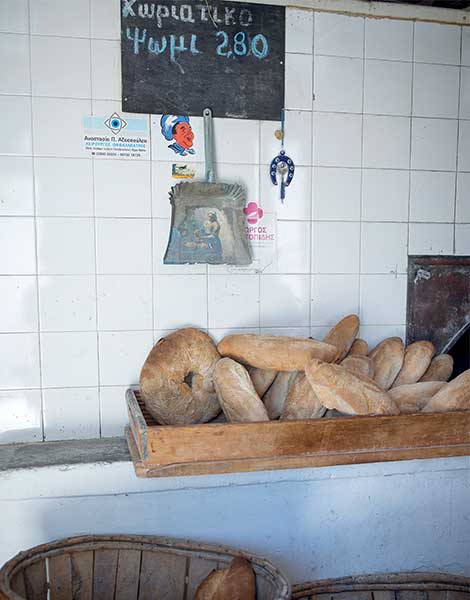
Bread and pastries at Fournos Apeirathou.
© Dimitris Tosidis
Our journey repeatedly takes us into the heart of Naxos, where the ancient temples, large villages, livestock farmers, and cheesemakers are found. At the Temple of Demeter at Gyroula Sangri, wildflowers, fields, and stone walls create a timeless landscape, which evokes the ancient times when the goddess of agriculture was worshipped here. The archaic temple (about 525 BC), with its white columns, has been meticulously restored, coexisting peacefully with the nearby Christian church. It is a productive and bountiful land, as suggested by the temple and the surrounding landscape.
Local farmers like Giorgos Voulgaris, who runs a visitable farm on the boundary of Sangri and Damarionas, are based only a few kilometers away from the sanctuary. “This is the most productive part of Naxos, the heart of livestock farming,” says Voulgaris. He has 200 sheep and 25 goats and grows barley and oats to feed them (“though it’s not enough due to recent droughts”), as well as fruits, vegetables, and herbs, which his father sells as a traveling vendor around the villages or wholesale to Koufonisia and Schinoussa. The cheeses, arseniko, kefalotyri, sweet and sour mizithra, xinotyro, and anthotyro, are their biggest draws. Just 3.5 kilometers to the southwest lies Yiannis Vavoulas’ Armeos Farm. After navigating a challenging uphill road, visitors reach a rustic courtyard with tasting tables, enclosed by Yiannis’ father’s cheesemaking plant, as well as a small museum displaying traditional livestock farming tools. In the fields, sheep, chickens, and a dog chase after each other.
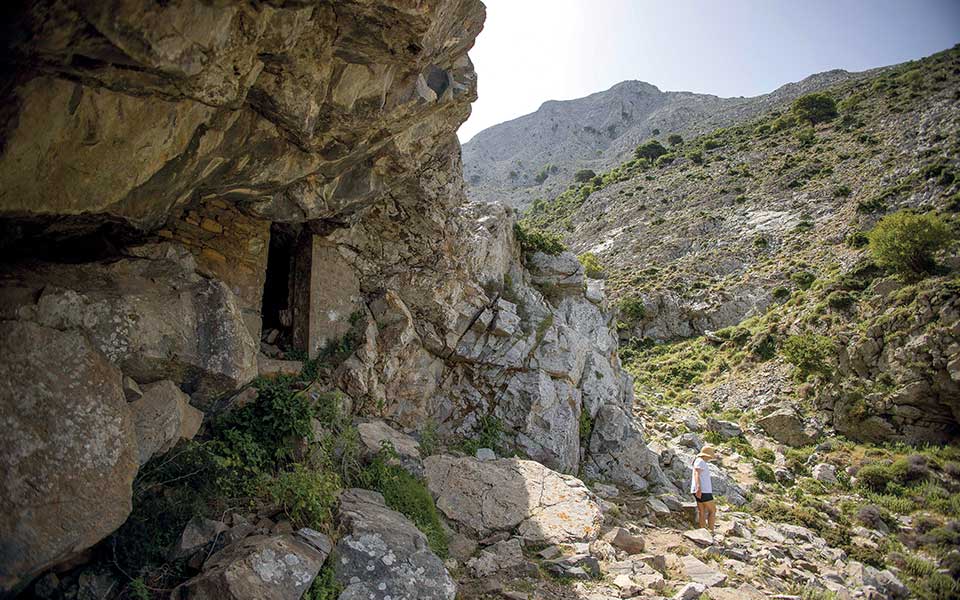
The entrance to the cave of Mount Zas, where Zeus is said to have grown up.
© Dimitris Tosidis
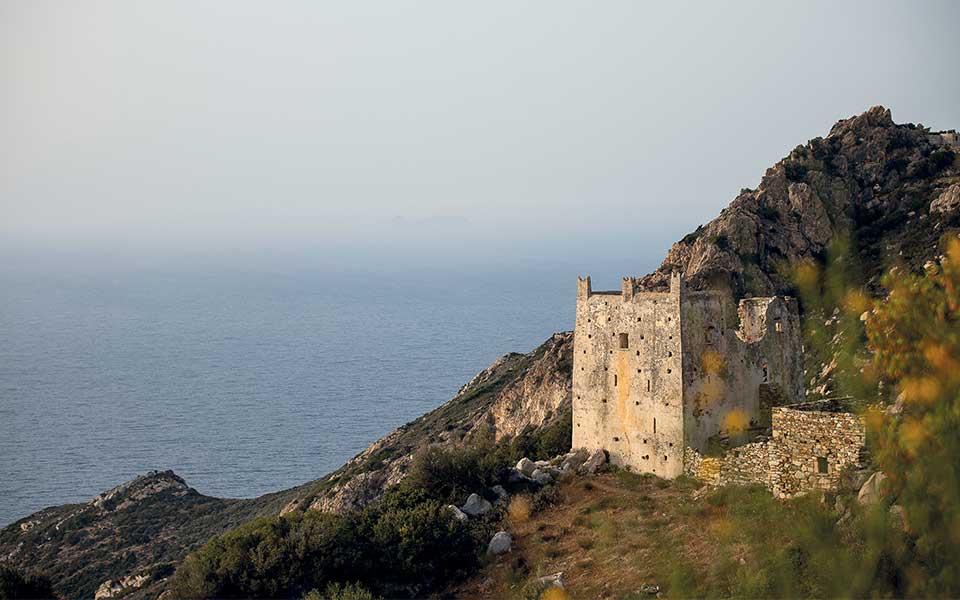
The ruined Tower of Aghia.
© Dimitris Tosidis
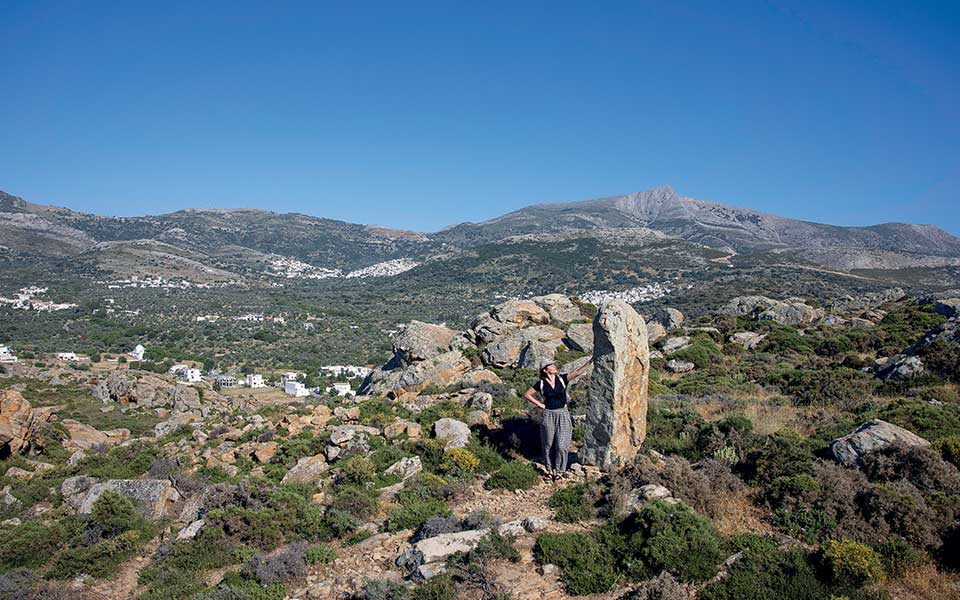
The Tsiakalario Menhir, in the geometric era necropolis near the village of Tsiakalario.
© Dimitris Tosidis
The mini tour concludes at Terra Grazia, Angeliki Gratsia’s visitable winery in Kato Sangri, which includes a 600-year-old Venetian tower, an old bakery house converted into a guesthouse for friends, and the Catholic chapel of Saint Nicholas of Tolentino, which is now used as an Orthodox church. Angeliki and her team grow Aegean grape varietals (Assyrtiko, Aidani, and Monemvasia for whites; Mandilaria, Mavrotragano, and Fokiano for reds). They also engage in viticultural research; they discovered and identified unknown grape varietals (Bastardiko, Engaritiko, Austiano, Aspro Siriki, Charabraim, and Vourliotiko) that originate from Asia Minor, once a popular destination for immigrants from Naxos.
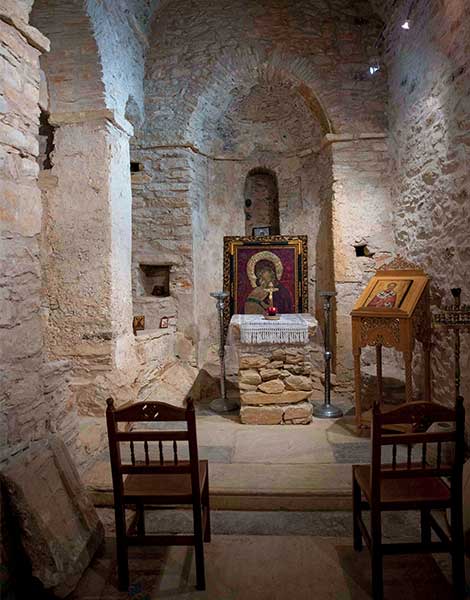
Inside the Fotodotis Monastery.
© Dimitris Tosidis
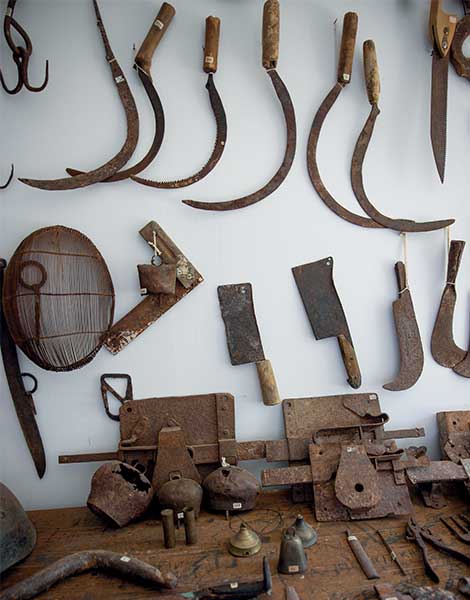
Agricultural tools from another era at the Folklore Museum of Apeiranthos.
© Dimitris Tosidis
Naxos has a variety of charming and unique villages, each with its own character. Among them, Apeiranthos (Aperathou) stands out. This medium-sized village on the slopes of Fanari is beautiful and tourist-friendly and boasts the famous church of Panagia Aperathitissa. The town is inextricably linked to the life of Manolis Glezos (1922-2020), a WWII resistance activist and leftist politician whose legacy is cherished by all. Apeiranthos owes its wealth to its emery mines, which allowed villagers to pursue education and cultural growth. This progress is reflected in the village’s numerous cultural sites. The Museum of Fine Arts showcases works by local artists; the library contains publications on Aperathitic culture; and the Archaeological Collection of Apeiranthos (Michalis Bardanis Museum) features artifacts from southeastern Naxos, including rock paintings of ships and fragments of early Cycladic figurines. The local vernacular is quite distinctive, although it is more entertaining to hear inhabitants use it between themselves rather than at visitors.
Chalki, located west of Apeiranthos, is a little village with old mansions and a distinctly urban ambiance. One notable attraction is the Vallindras Distillery, where citron leaves are distilled. A tour of the production area offers insights into the island’s traditional citron liqueur.
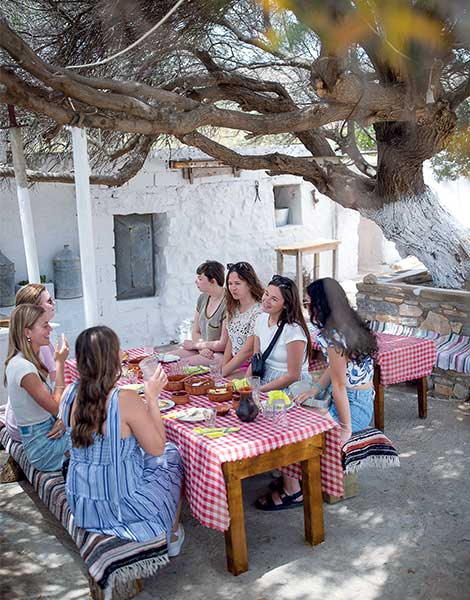
At the visitable Armeos Farm of livestock farmer Yiannis Vavoulas.
© Dimitris Tosidis
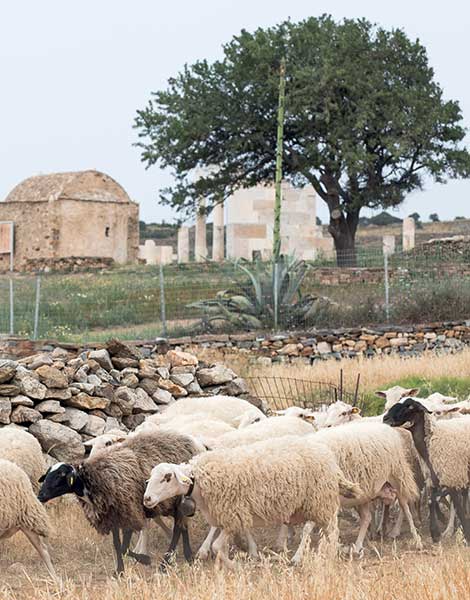
Giorgos Voulgaris' herd crosses fields near the Temple of Demeter.
© Dimitris Tosidis
Filoti, located east of Halki, is built amphitheatrically on the slopes of Mount Zas (Zeus). It is one of the largest villages in the Cyclades, known for landmarks that include the Church of Panagia Filotitissa, the Folklore Museum, and the revitalized Fasola market, which houses old commercial spaces such as barber shops, grocery stores, and tailor shops that have been restored. Filoti’s true distinguishing feature is its thriving population, estimated at 1,000 to 1,500 people. In Filoti, elderly residents sip coffee under plane trees, children rush by on bicycles, and shepherds talk milk prices, creating a lively and nostalgic village scene.
Danakos, located east of Filoti, is not as well known. Life here is simple and peaceful, with limited options. A stroll through the narrow streets and a stop at the only shop that was open in late May resulted in a plate of stuffed vegetables, complete silence, and intermittent internet access. These modest luxuries define the tranquil charm of Danakos.
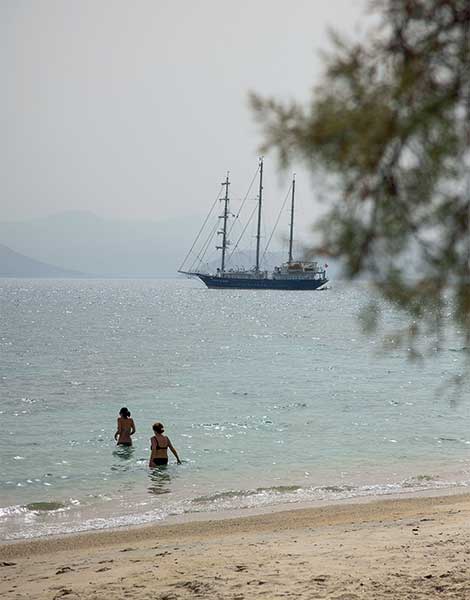
Plaka beach.
© Dimitris Tosidis
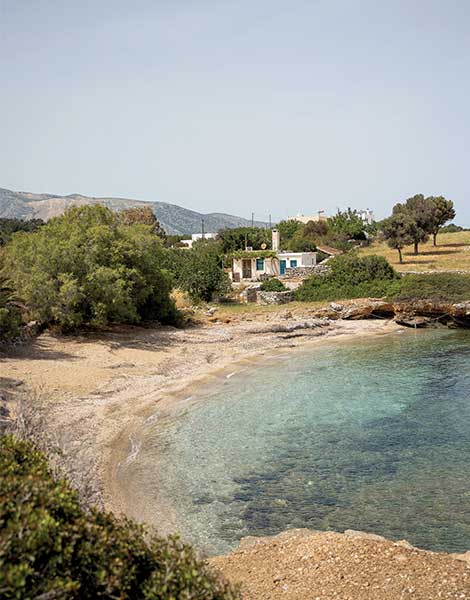
A small beach in eastern Naxos, near the port of Moutsouna.
© Dimitris Tosidis
We saved Hora, this endlessly charming urban center of the Aegean, for last. The Venetian Castle of Marco Sanudo, who conquered Naxos in the Middle Ages; the Archaeological Museum with its famous collection of early Cycladic figurines (housed in the Commercial School, where Kazantzakis studied); the Medieval structures, Catholic landmarks, arches, and labyrinthine layout that makes it impossible not to get lost; all make up a unique and enduring island town. Beyond it is the islet of Palatia, with the imposing marble Portara, the gateway to a temple built in the 6th century BC.
From Hora, all roads lead to the sea. Naxos’ coastline is primarily sandy, and some of the nicest beaches are located near the main town. Aghios Prokopios and Aghia Anna are two adjacent beaches with facilities that can get very busy with tourists; if you want privacy, go early in the morning or at sunset. Further south, Maragas, Plaka, and Orkos beaches are less crowded, and nearby Mikri Vigla is ideal for kite surfing. The locals recommend the secluded beaches of Hawaii and Aliko for a more relaxed experience. Agiassos is a popular destination in the southeast, famed for its breathtaking sunsets. Other notable beaches include Panermos, beneath the fortified prehistoric acropolis of Panormos, and Ligaridia, near the small port of Moutsouna, where you can enjoy a meal after a swim. No matter which beach you choose, you’ll have a prime view of the surrounding islands: Paros from Aghia Anna, Donousa from Ligaridia, and Koufonisia, Keros, Schinoussa, and Iraklia from Panermos.
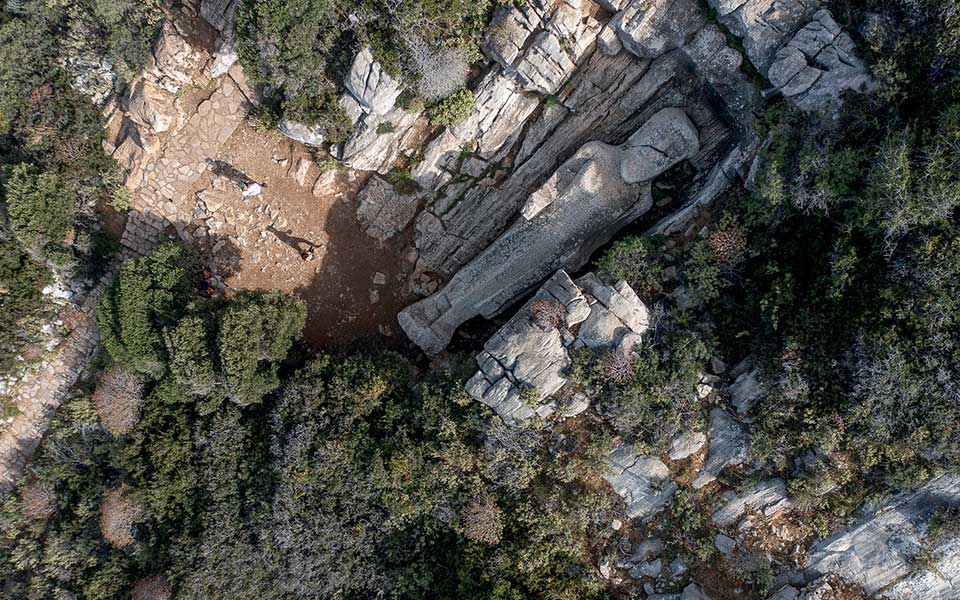
The Kouros of Apollonas, the largest of the three Naxian Kouros statues, is believed to represent Dionysus.
© Dimitris Tosidis
Naxos is one of the few Greek islands with a strong primary sector. The Union of Agricultural Cooperatives of Naxos, founded in 1926, includes 598 livestock farmers and around 300 farmers who grow fruits, vegetables, animal feed, and, most notably, potatoes. The Naxos potato, a PDO product now cultivated using Dutch-French seeds, thrives in sandy soils enriched with manure and is sold across Greece. The union’s retail outlet offers a variety of premium cheeses and dairy products (kefalotyri, PDO graviera, xinotyro, mizithra, xinomizithra, butter, fresh milk, yogurt), local meats, and deli products, as well as specialties from other Cycladic islands, such as Santorini fava and tomatoes, Mykonos kopanisti, and Amorgos psimeni. The union also operates a radio station, Aegean Voice 107.5, with part of its programming dedicated to traditional music.
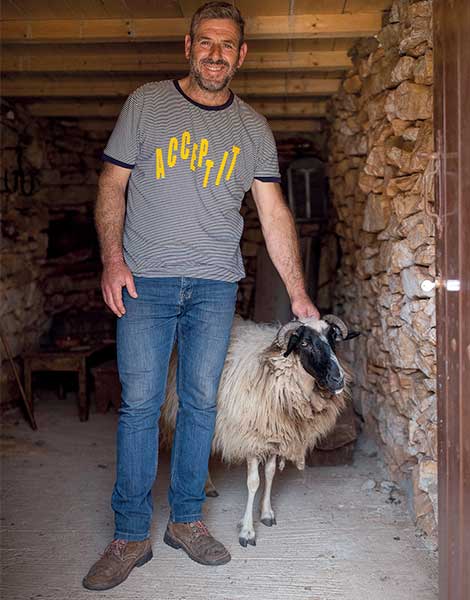
Yiannis Vavoulas with one of his sheep at the small livestock farming museum on his estate.
© Dimitris Tosidis
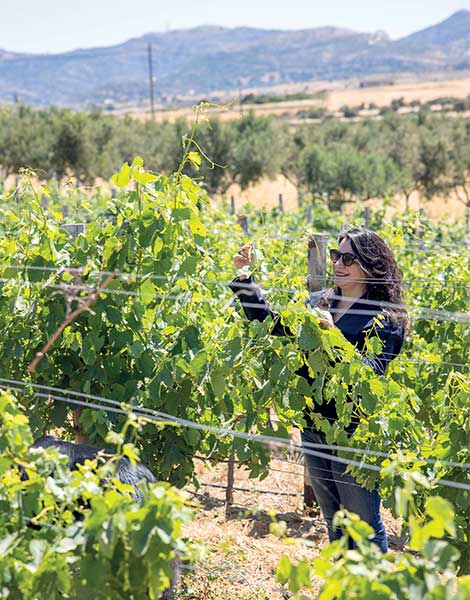
Angeliki Gratsia in the vineyards next to the Terra Grazia winery.
© Dimitris Tosidis
Naxos offers several hiking trails, with one of the most famous leading to the cave of Mount Zas, where, according to mythology, Zeus grew up after fleeing Crete from Cronus. The trail starts at the Aria Spring, south of Filoti, and takes about half an hour, traversing a landscape of low vegetation. It is enjoyable but demanding, as you’ll need to use your hands to navigate the rocky sections. The second hike is easier and lasts 10-15 minutes, leading to a lesser-known historical site, the Tsiakalario Menhir. This monument is what remains of a geometric era necropolis (9th-8th century BC) near the village of the same name. Search for “Tsiakalario Menhir Path” on Google Maps to find it. Both hikes are best undertaken early in the morning or late in the afternoon during this season. It is also worth visiting two monuments of Naxos that have no equal in the Aegean: the Early Christian Panagia Drosiani near Halki, with its 6th-century frescoes, and Fotodotis Monastery, near Danakos, a Byzantine fortress monastery with remarkable architecture and a shady plane tree in its courtyard.
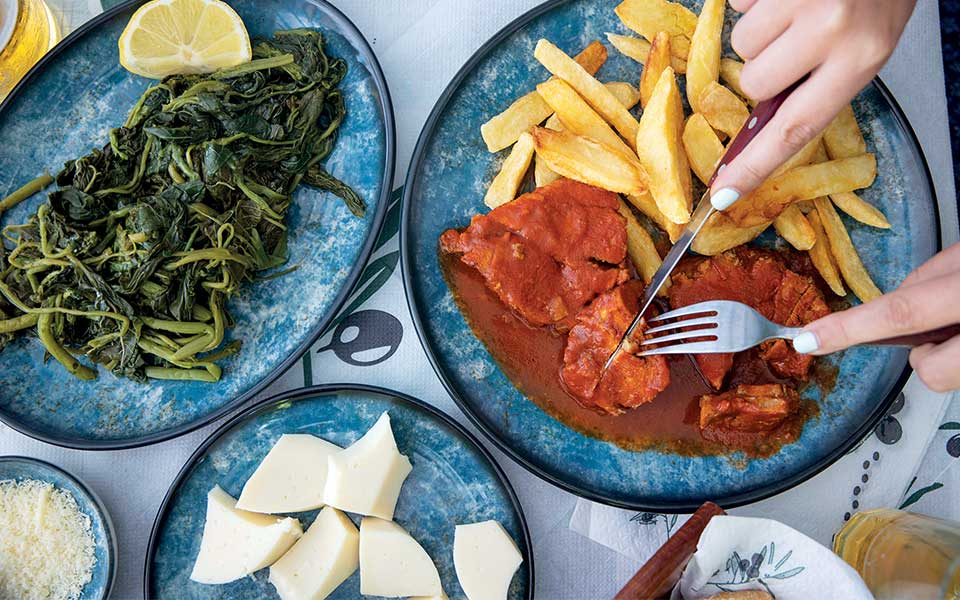
Rosto, greens, and Naxian cheese at Giannoulis Tavern in Aghios Prokopios.
© Dimitris Tosidis
You can reach Naxos by air with Olympic Air and Sky Express (average round-trip ticket price is 120 euros) or by ferry from the ports of Piraeus (starting at 51.50 euros one way) and Rafina (starting at 43 euros one way).
Naxos is a large island, so it’s best to choose your accommodation based on where you plan to spend your time. Hora and the nearby beaches of Aghia Anna and Aghios Prokopios offer many lodging options, but the mountainous and quieter villages are also worth considering.
Arco Naxos Luxury Apartments, Tel. (+30) 697.383.7459, (+30) 697.686.3142, Rates: from 130 euros for two people, Location: Prime spot in Hora, near the port, with apartments featuring a living room and equipped kitchen.
Pension Sofi,Hora Naxos, Tel. (+30) 22850.230.77, Rates: from 80 euros for two people, breakfast included, Features: Beautiful rooms with simple decor
The Saint Vlassis Hotel, Hora Naxos, Tel. (+30) 22850.235.36, Rates: from 80 euros for two people, breakfast included
Adonis Hotel, Apollonas, Tel. (+30) 694.794.8147, Rates: from 49 euros for two people
Imellos Hotel, Apeiranthos, Tel. (+30) 697.443.8448, Rates: from 216 euros for two people for two nights
Xerolithos, Kato Sangri, Tel. (+30) 697.712.5799, Rates: from 103 euros for two people
Naxos’s restaurants celebrate both Cycladic cuisine and international flavors, offering a wide range of choices.
Alphabetari in Danakos, Tel. (+30) 694.662.6798, Specialty: Traditional Greek dishes
Bakalogatos in Apeiranthos, Specialty: Mediterranean flavors and generous portions
Fournos Aperathou in Apeiranthos, Tel. (+30) 22850.614.92, Specialty: Pastries and snacks for daily outings
Vasilarakio Tavern in Kinidaros, Tel.(+30) 22850.320.88, Specialty: Expertly prepared meats
Nikos Tavern in Apollonas, Tel. (+30) 697.748.6971, Specialty: Quality meals with a sea view
To Elliniko in Hora, Tel.(+30) 22850.270.50 (reservation required), Specialty: Handmade dolmades, soutzoukakia, and Naxian rosto (pork in a garlic and pepper tomato sauce)
Nostimo in Hora, Tel. (+30) 22850.258.11, Specialty: Mediterranean dishes
Spitiko in Hora, Tel. (+30) 22850.262.12, Specialty: Souvlaki
This spring, five majestic peaks across...
A weekend on the Saronic Gulf’s...
Discover Leros, a hidden Greek island...
Discover hidden beaches, authentic tavernas, ancient...